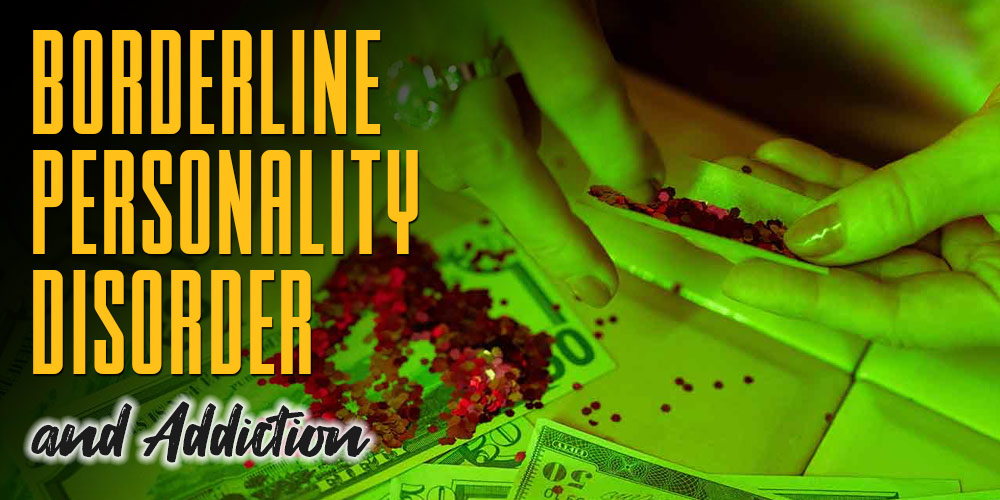
Examining the correlation between the 10 types of personality disorders and substance use, one of the most common links appears with Borderline Personality Disorder and addiction.
When it comes to mental health and issues of substance abuse or addiction, there is undoubtedly a direct connection.
In some cases, a substance use disorder can lead to problems with mental health as the brain adapts to the use of drugs or alcohol to do the work previously accomplished from the natural role of feel-good neurotransmitters.
In other instances, conditions like Borderline Personality Disorder (BPD) can drive self-destructive, impulsive, and addictive behaviors like alcohol or drug use to cope with depression or mood issues.
BPD is one of two personality disorders most closely tied to addiction and also suicide or self-harm.
May is recognized as Borderline Personality Disorder Month, so it’s a good time to learn more about this mental health issue and the possible risks of it leading to addiction.
What is Borderline Personality Disorder?
Borderline Personality Disorder, or BPD for short, is a condition characterized by “an ongoing pattern of varying moods, self-image, and behavior” that often results in reckless actions and a history of troubled relationships, according to the National Institute of Mental Health (NIMH).
This personality disorder is associated with severe mood shifts and a constantly changing sense of identity that affects the way a person interacts, relates to, and understands others.

Nearly 1.5 percent of the population is estimated to struggle with symptoms of borderline personality disorder, and around two-thirds of those people have also battled substance abuse at some point in their lives.
Issues with substance abuse can develop when people with BPD use drugs or alcohol to mask or self-medicate their symptoms. It can very quickly become a cycle that leads to dependency and ultimately addiction.
Causes of Borderline Personality Disorder
With both borderline personality disorder and substance use disorders, the root cause is not entirely understood, though there’s plenty of evidence about some of the risk factors that are involved with the conditions.
The first possible cause of borderline personality disorder is genetics. A person with a family history that includes mental illness, like borderline personality disorder and addiction, are more likely to suffer similar problems.
Research also shows that people with borderline personality disorder sometimes have functional or structural changes in the brain that are associated with areas that control emotional regulation and impulse control.
Lastly, environmental and social risk factors can play a role in borderline personality disorder symptoms.
A lot of people that suffer from either addiction, borderline personality disorder, or a combination of the two, have suffered past trauma, dealt with abandonment at an early age, or been exposed to hostile or extremely unstable relationships.
Not everyone who experiences these risk factors will develop borderline personality disorder and addiction.
Additionally, research has yet to reveal why others who have never experienced these problems sometimes develop these conditions.
Symptoms of Borderline Personality Disorder
There is quite a bit of crossover as it relates to the symptoms of addiction and borderline personality disorder.
In fact, BPD often goes undiagnosed because the symptoms are mistaken solely for a substance use disorder.
This is why it can be difficult for a person to get the appropriate form of treatment as soon as problems present.
Common symptoms of borderline personality disorder can include:
- Intense, seemingly irrational fear of abandonment or being alone
- Unstable, often fluctuating sense of self-image
- Severe emotional swings, along with episodes of serious anxiety or depression
- Reckless, impulsive, and often manipulative behavior toward others
- Unfounded suspicions of others motives
- A sense of paranoia
- Struggles with substance abuse and addiction
- Self-harming or suicidal tendencies
- Eating disorders

In connection with the symptoms listed, there are some mental health conditions that co-exist or are co-morbid with BPD, meaning people suffer with borderline personality disorder and something else at the same time.
It’s estimated that 60 percent to 70 percent of people with BPD struggle with some type of depression.
Approximately 55% to 85% of people with BPD have issues with self-harm or self-injury, and another 35% experience borderline personality disorder and addiction.
An additional 25 percent of individuals with BPD encounter some form of eating disorders.
The most common co-morbid personality disorders with BPD include antisocial and narcissistic personality disorder.
Treatment for Borderline Personality Disorder and Addiction
The presence of both a mental health condition and a substance use disorder like borderline personality disorder and addiction is known as a co-occurring disorder. The symptoms of each condition often amplify or worsen the issues of the other.
A full recovery is unlikely if both disorders are not diagnosed and treated at the same time in a dual diagnosis treatment program. However, people can and do improve when both matters are appropriately addressed.
The same is true for BPD and depression, and both conditions must be successful treated to find relief for both.
Dialectical Behavior Therapy (DBT) helps people examine their actions, works on acceptance, and develops change-oriented strategies. DBT was specifically developed to treat people with borderline personality disorder and it’s one of the most commonly used treatment therapies for BPD.
Cognitive Behavioral Therapy (CBT), another psychosocial intervention, is less about a person’s actions and more focused on identifying patterns of thought that lead to negative or self-destructive feelings and behaviors.
Over time, this skillset is extremely effective at helping patients dismiss unwanted impulses and thought patterns.
When combined with addiction treatment, people can recover from a dual diagnosis of substance use and borderline personality disorder.
It takes willingness on the part of the patient, as well as support, compassion, and understanding from those closest to them to have a positive impact on their condition and recovery.

May is Borderline Personality Disorder Month
The National Education Alliance for Borderline Personality Disorder (NEABPD) was founded in 2001 to educate the public about BPD, raise awareness about the disorder, promote research, decrease the stigma, and improve the quality of life for those affected by it.
The NEABPD website is an excellent source for people looking for more information about BPD, including support for families and industry professionals, as well as news, publications, and conferences.
In 2008, the U.S. House of Representatives officially declared the month of May as Borderline Personality Disorder Awareness Month.
May is a good time to watch movies about borderline personality disorder to learn more about the disorder and get a better understanding of how it impacts others.
Mental health issues like borderline personality disorder don’t have to lead to addiction or substance use to cope with the symptoms if the illness is diagnosed and treated early.
Early intervention and seeking help at the first signs of a problem will have the most profound affect on recovery.
Related Posts
- Movies About Borderline Personality Disorder BPD
The prevalence of mental health might not be a common topic of discussion, but we…
- Borderline Personality Disorder vs Bipolar - Is BPD Worse?
Understanding and distinguishing the differences between Borderline Personality Disorder vs Bipolar Disorder can be difficult…
- Addictive Personality Disorder
The last decade has seen an increase in reported cases of substance abuse. Behavioral addictions…
